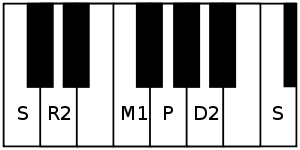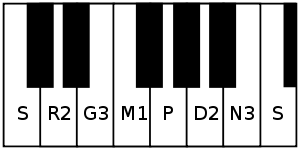- Devagandhari
-
Devagandhari (pronounced devagāndhāri, Sanskrit: देवगांधारि Tamil: தேவகாந்தாரி) is a raga (musical scale) in Indian classical music. It is used in the Sikh tradition of northern India and is part of the Guru Granth Sahib. In the South Indian classical music, Devagandhari is a janya raga (derived scale), whose melakarta raga (parent scale, also known as janaka) is Shankarabharanam, 29th in the 72 Melakarta raga system.
Contents
In Sikh tradition
In the Sikh tradition from northern India it is part of the Guru Granth Sahib. Every raga has a strict set of rules which govern the number of notes that can be used; which notes can be used; and their interplay that has to be adhered to for the composition of a tune. In the Guru Granth Sahib, the Sikh holy Granth (book), there are a total of 31 raga compositions and this raga is the sixth raga to appear in the series. The composition in this raga appear on a total of 10 pages from page numbers 527 to 537.
Today Devagandhari is a rare, little known, ancient raga. Its performance time is the morning hours. Historically it has had three forms; the less ornamented type is described here. In the Ragmala, Devagandhari is a ragini of Malkaunsa. Today it belongs to the Asavari thata. Its mood is one of prayerful supplication presenting a heroic effect. The texts set to this raga reveal a heroic search for these qualities which lead one to the Lord. This raga was used primarily by Guru Arjan. Forty-Seven hymns were composed to it including three by Guru Tegh Bahadar and six by Guru Ram Das.
- Aroh: Sa Re Ma Pa Dha Sa
- Avroh: Sa Ni Dha Pa, Ma Pa, Dha Ni Dha Pa, Ma Ga Re Sa
- Pakar: Dha Ni Dha Pa, Ma Ga, Sa Re Ma, Ga Sa Re Ga Sa
- Vadi: Ma
- Samvadi: Sa
See also
In Carnatic music
Structure and Lakshana
Its ārohaṇa-avarohaṇa structure (ascending and descending scale) is as follows (see swaras in Carnatic music for details on below notation and terms):
Devagandhari ragam is an owdava-vakra-sampurna raga meaning, in arohana 5 swaras come (so it is called owdava) and in avarohana all swaras come (so sampurna), and there is a "zigzag" pattern of notes (so vakra). The notes used in this ragam are shadjam, chathusruthi rishabham, antara gandharam, shuddha madhyamam, panchamam, chathusruthi dhaivatam and kakili nishadham. This ragam sometimes includes the kaishika nishadham (anya swara – a note external to the scale, making this a bhashanga ragam).
The closest raga to this one is Arabhi. Some of the things that makes Arabhi different (though both share the same ascending and descending scale, in terms of basic notation) are:
- Devagandhari is sung with gamakas and vilambita kala prayogas (usages with elongated notes)[1]
- Devagandhari is sung with dheerga gandharam (elongated G3)[1]
- Devagandhari is a bhashanga raga, and certain prayogas use the kaishika nishadham: S N3 D N2 , , D P
Popular Compositions
Here are some more compositions set to Devagandhari.
Type Composition Composer talam Kriti Ksheerasagara Thyagaraja Adi Kriti Vinaradana manavi Thyagaraja Adi Kriti Koluvaiyunnade Thyagaraja Adi Kriti Tulasiamma Thyagaraja Adi Kriti Enneramum Gopalakrishna Bharathi Adi References
External links
Ragas in the Guru Granth Sahib Melakarta Ragas Shuddha
Madhyama
RagasIndu chakraNetra chakraAgni chakra13. Gayakapriya · 14. Vakulabharanam · 15. Mayamalavagowla · 16. Chakravakam · 17. Suryakantam · 18. HatakambariVeda chakra19. Jhankaradhvani · 20. Natabhairavi · 21. Keeravani · 22. Kharaharapriya · 23. Gourimanohari · 24. VarunapriyaBana chakra25. Mararanjani · 26. Charukesi · 27. Sarasangi · 28. Harikambhoji · 29. Dheerasankarabharanam · 30. NaganandiniRitu chakra31. Yagapriya · 32. Ragavardhini · 33. Gangeyabhushani · 34. Vagadheeswari · 35. Shulini · 36. ChalanataPrati
Madhyama
RagasRishi chakraVasu chakra43. Gavambhodi · 44. Bhavapriya · 45. Shubhapantuvarali · 46. Shadvidamargini · 47. Suvarnangi · 48. DivyamaniBrahma chakra49. Dhavalambari · 50. Namanarayani · 51. Kamavardani · 52. Ramapriya · 53. Gamanashrama · 54. VishwambariDisi chakra55. Shamalangi · 56. Shanmukhapriya · 57. Simhendramadhyamam · 58. Hemavati · 59. Dharmavati · 60. NeetimatiRudra chakra61. Kantamani · 62. Rishabhapriya · 63. Latangi · 64. Vachaspati · 65. Mechakalyani · 66. ChitrambariAditya chakra67. Sucharitra · 68. Jyoti swarupini · 69. Dhatuvardani · 70. Nasikabhushani · 71. Kosalam · 72. RasikapriyaCarnatic music · Swaras · Ragas · Asampurna Melakarta Ragas Janya Ragas A-D Abheri · Abhogi · Andolika · Amritavarshini · Anandabhairavi · Arabhi · Atana · Bhairavi · Bhupalam · Bilahari · Devagandhari · DhanyasiG-K M-N Madhuvanti · Madhyamavati · Malahari · Malayamarutam · Mohanakalyani · Mohanam · Nagasvaravali · NiroshtaR-S Ranjani · Revati · Sahana · Saramati · Saveri · Shivaranjani · Shuddha Saveri · Shree ranjani · SunadavinodiniU-V Udayaravichandrika (Shuddha Dhanyasi) · ValajiCarnatic music · Melakarta Ragas · Asampurna Melakarta Ragas · List of Janya Ragas Categories:- Sikh kirtan
- Carnatic Ragas
Wikimedia Foundation. 2010.


